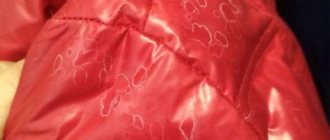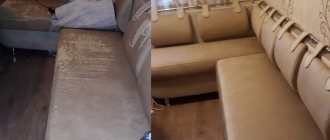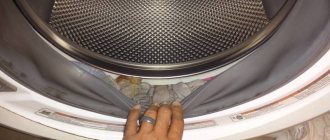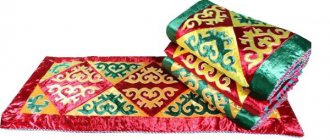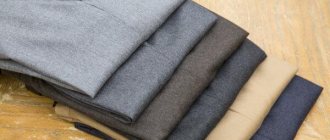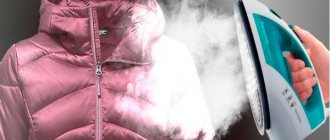Among the fasteners for clothing there are buttons that are not sewn on, but are installed in a specific place using a special device. Like a sew-on button, such a button consists of two parts; in one of the parts (the top one, which is visible from the front side of the garment) there is a hole, and in the other (bottom) there is a cylindrical protrusion corresponding to the diameter of the hole. When the cylinder enters the hole, the button parts close together and connect the garment parts on which they are installed to each other. Unlike a sew-on button, each part of the button shown in the photo consists of two more parts, which are installed on both sides of the fabric and tightly fixed into each other.
If you have a need to shorten the sleeve of a purchased shirt, and there is nothing else left to do but tear off the cuffs, trims and facings, cut off the excess length from the bottom of the sleeve, decorate the cut at the bottom of the sleeve with the same facings and trims (since the shirt was not sewn by you, and a suitable there is no new fabric for the pattern), sew cuffs to the new line of the bottom of the sleeves, you may encounter the following situation. One of the parts of the button fastener may be located very close to the edge of the facing or even partially extend onto the fabric of the sleeve part; in this case, it will not be possible to sew the facing to a new place without dismantling the button, since it will prevent the sleeve fabric from entering between the layers facings.
Let's try to carefully dismantle (remove from the fabric) the lower part of the fastener button and install it in a new place.
We will need: a thin flat-head screwdriver and pliers.
Removing the fastener part
Carefully insert the end of the screwdriver between the fabric and the base of the fastener button, checking if there are spikes that attach the base to the fabric. They are there, but they are short, so we slightly bend the base disk to remove the spikes, but not damage the fabric or break the button. This way we check the details of the button on both sides of the fabric.
Now we place the screwdriver between the base of the fastener button and the fabric from the inside, as deep as possible, carefully scroll and separate the parts of the button from each other. A hole remains in the facing the size of the button cylinder.
Installing the snap button part
We stitch the facing to the corresponding side of the new cut. We make a hole in the sleeve fabric between the facing layers.
From the reverse side, insert the lower part of the button-fastener into the hole, the fabric of the hole should tightly surround the cylinder of the button, cut off the fringe, and press the fabric tightly to the base of the button. From the front side we put the upper one on the lower part of the button. Using pliers, lightly squeeze them (be careful not to damage the shape of the protrusion) until you hear a click (there should be a click, it indicates that the parts of the button fastener fit tightly into each other and will not separate without impact).
This is how you can carefully move the bottom part of the button yourself without using special equipment.
Share on social media networks:
Accessories for clothing are an additional decoration and accessory. However, even expensive branded clothing is often equipped with low-quality fittings. This applies to both buttons and clips, hooks and zippers. In order not to seek help from a studio, you need to learn how to work with various sewing accessories yourself. Installing buttons on clothes at home will not take much time; this can be done using a simple set of tools. Today we will tell you how to put a rivet on clothes at home, using available materials and tools, thereby saving money by not buying a special press for installing buttons.
How to remove rivets from clothes
Lightly squeeze the button, then turn the side cutters at an angle of 90 ° and squeeze again (as if squeezing it out), and so on several times until the button collapses. If you try to remove the button in one step, you can irreversibly damage the fabric.
2. Asian buttons
Since Asian-made buttons are made of thinner metal than European ones, they can be removed simply with pliers.
We squeeze the button with pliers, turn the pliers at an angle of 90 and squeeze again, if necessary, repeat the operation several times.
Do not try to remove Turkish buttons this way.
You'll just be wasting your time.
3. Drilling. This method must be used very carefully, as you can wrap the fabric of the product around the drill and damage it irrevocably. It is worth using drilling if it is necessary to reuse the spring part of the button or if there is no other way to remove the button.
We clamp the spring part of the button with pliers:
We use a drill Ø3.5mm.
It is necessary to drill out the flared part of the front part of the button
After this, the button can be easily removed.
The spring part of the button can be used for re-installation.
4. Decorative composite buttons can be easily disassembled using a side cutter.
If you don’t have a side cutter, you can pry it out with a flat bladed screwdriver and turn it at an angle of 90°. Be careful not to damage the fabric.
5. Removing the bottom of the button:
Also with the help of side cutters.
Don’t try to eat a bite at once; squeeze the button part, then turn the side cutter at an angle of 90° and squeeze again, and so on several times.
You can do everything!
Attention: high-quality installation of fittings can only be done in an atelier or workshop using appropriate professional equipment.
The rivet is an excellent and durable type of fastener. But unlike bolts, nuts, studs and screws, it cannot be removed without damaging it. The bolt can be unscrewed with keys or a screwdriver, after which it can be reused. The broken rivet will have to be thrown away. The question also arises: “How to rivet rivets if there is no riveter in your arsenal?”
The essence of the rivet
The rivet is a disposable fastener. But it is also the cheapest. If the device is being made permanently and does not involve disassembling parts in the future, these parts can be riveted together. They will hold just as firmly as screws, but will be even more reliable. The screw may come out over time, but the rivet itself will not come apart, since it is impossible to rivet it without the help of special tools.
Rivets in construction and mechanical engineering
There are many types of rivets. Some have the form of a single part - a bushing, which is inserted into the hole and, using a special riveter, the edges of the bushing are expanded on the other side of the parts being connected and pressed (flatten). Such rivets are the most common, cheap and reliable. They are used mainly in construction and mechanical engineering. How to rivet construction types of rivets?
Removing a construction rivet
It is difficult to call this action dismantling as such. This is removal. To remove the rivet, you will need the regular rivet gun that was used to install it. But since you don’t have one at hand, it’s worth figuring out how to rivet a rivet without a riveter.
You can try to remove rivets in which the head or bent part protrudes above the plane of the riveted parts with a sharp chisel and hammer:
- Place the cutting part of the chisel exactly under the head (or bent part).
- Hit the chisel with a hammer. Some large rivets may take several hits to break off.
- Once the head (or bent part) is torn off, all that remains is to remove the rivet from the hole. This can be done by pushing it out with a nail or other thin object (for example, a screwdriver).
But more often you cannot get to the caps and curved parts, since they are, as it were, in the body of the parts being fastened. At the factory, special grooves are drilled for the caps and expanding parts in the parts, and then the rivets fit into the metal like a glove. How to rivet rivets in such a “tricky” case?
Here a screwdriver (or drill) with a metal drill selected for the diameter of the rivet will come to the rescue. Proceed as follows:
- Using a core, make a notch on the head of the rivet so that the drill does not wander, although some are accustomed to doing without serifs.
- Place the screwdriver bit on the head and drill out the inside of the rivet.
- When the drill goes through, the remains of the head and widened part fall out on their own.
Rivets on clothes
But rivets are also used in the manufacture of various types of clothing. Their use began in the 19th century, when, while sewing pants made of rough canvas, which will later be called jeans, one of the craftsmen noticed that if the seam is riveted at the beginning, it will definitely not come apart or tear.
Here rivets are used, for which the name “buttons” is more appropriate. Unlike ordinary ones, they consist of two parts - internal and external. Everything is held together by the fact that the head of one element fits into the cavity of another. Then, under pressure from the riveter, the head of the internal element is flattened (expanded) inside the cavity of the outer element, and such a “super button” cannot be broken, no matter how hard you try. The fabric is more likely to tear. How to rivet these types of rivets correctly?
Removing rivets from clothing
This is done in two ways. One - with the help of side cutters, the other - with a knife and a pair of pliers. The choice of methods depends on what type of rivet you have - alpha (internal) or beta (external). The corners and edges of the stitching are mostly riveted with alpha varieties, otherwise known as grommets. Beta is used in cases of buttons used to fasten clothing. One part there is alpha, and beta is riveted onto it. Despite the fact that such rivets hold the material perfectly, they are afraid of mechanical stress.
How to rivet alpha rivets using a knife and two pliers?
- Carefully, so as not to damage the fabric, insert a sharp knife blade under the edge of the wide part of the rivet on one side and bend it back so that the edge can be grabbed with pliers.
- Do the same with the opposite part of the rivet. Insert the knife blade and bend the edge.
How to rivet a beta rivet on clothes? Everything is even simpler here. The procedure is as follows:
- Grasp the garment with the widened (curved) part of the rivet protruding inside the pressure washer facing you.
- Take side cutters (it is advisable to use those with pliers), place them under the very bottom of the widened part and squeeze.
wikiHow works like a wiki, which means that many of our articles are written by multiple authors. This article was created by volunteer authors to edit and improve it.
Number of sources used in this article: 5. You will find a list of them at the bottom of the page.
Rivets are a type of fastener that is used in everything from racing cars to yachts. The rivets are lightweight and install quickly and easily. A modern rivet consists of two parts, a punch and a head. A hole is drilled in the parts to be fastened, a rivet is inserted, and a punch is pulled out with a special tool. The punch ball flares the tube, forming a closing head, thereby securely securing the part; the rest of the rod comes off. The diameter of the rivets varies from 1.4 to 6 mm, rivets are made from brass, aluminum, steel, copper and monel. Rivet joints are cheap and strong and can be used instead of welding, screws and bolts. However, such a connection may become loose, requiring removal and replacement of the rivet. This manual describes several ways to remove a rivet without damaging the mounting hole, quickly and professionally.
Types of accessories
Garment accessories include the following parts:
- Buttons.
- Hooks.
- Loops.
- Lightning.
- Blocks.
- Textile Velcro fasteners.
- Holniten are metal rivets. Most often used in denim clothing to secure stitching.
- Buckles.
- Eyelets. Durable metal or plastic fasteners are mainly used in leather goods.
- Rivets. There are utilitarian rivets - those that are used for clamping, fastening and fastening, and decorative ones. Very often, sewing accessories in clothing combine both roles.
Important! All types of fittings are made from different materials. Often, their quality determines how convenient and comfortable a particular item will be worn. In addition, any accessories are designed to rivet and decorate clothes, even if we are talking about such an ordinary detail as a button.
The most popular materials for making fasteners and fasteners:
Important! Most often, sewing accessories are made from a combination of these materials in order to combine practicality and beauty in a single item. Read a detailed review about which fastener is best to choose for a dress, skirt, or jacket.
If the part is not selected correctly, that is, without taking into account the characteristics of the fabric or leather, then the fittings simply will not cope with their functions. Then you will have to change the details on your clothes yourself so as not to throw expensive things into the far corners of your wardrobe.
How to install a button on clothes at home?
Of course, if you have the opportunity, then entrust the installation of accessories to a master who has a special press, various devices, a set of tools, and most importantly, experience, thanks to which such work will not take him much time. If you don’t have this option, or you want to find out for yourself how to install a button on clothes, then prepare the following tools:
- Awl.
- Hammer.
- Forceps.
- Punch. You will have to purchase this tool. It is necessary to ensure that the hole is smooth and the edges of the fabric do not fray.
Important! You can purchase one punch (the smallest size), but it is better to buy a set of punches with removable attachments.
- An anvil (or another hammer).
Adviсe:
- Do not cut a hole for the block with scissors, as over time the button or block will definitely “fall out” of it. The hole for the button should be minimal, it is advisable to even slightly stretch the fabric over the leg, since the tighter the fabric is pressed against the part, the more securely it will be fixed.
- Punch a hole in leather or fabric using a wooden anvil (not metal) to avoid damaging the tip of the punch. The wood should be very dense (not loose). An area with a knot will do. You can use other dense materials as an anvil that will not damage the punch.
- Areas on knitted and bulk materials where holes will be punched can be glued with adhesive fabric so that the edges of the hole do not fray. You can also treat the edges of the hole with silicone glue.
Important! Don't start practicing fastening rivets on expensive clothes right away; practice on something cheaper first.
Rivet installation process
It is necessary to work with tools carefully, slowly and without making sudden movements. Otherwise, the fabric, accessories or tools may be damaged.
The most common type of installation of accessories is the installation of a block on clothing. In workshops and ateliers, forceps are used for this procedure. However, such a tool must be purchased of good quality so that the handles do not bend and the “cheeks” do not move.
Important! A sign of good and high-quality pliers are rigid handles that allow you to work quickly and easily.
Don’t despair if you don’t have special forceps at hand; you can do without them at home. Use the following step-by-step instructions:
- Use a punch to make a hole of the required diameter in textile material or leather.
- Thread the block leg and put a ring on it.
- Place the piece of clothing with the block on the anvil.
- Use a punch to split the stem of the block into petals. If all the steps are done correctly, the petals should bend on their own on the block ring.
- Lightly go over the block with a hammer to finally secure it to the fabric.
Important! Do not use much force when working with a hammer, otherwise you may damage the fabric and bend the block on the front side.
When working, place the ring with the convex side away from you so that it repeats the convex shape of the edge of the block.
How to attach buttons to clothes?
The most difficult process is installing rivets on the rough fabric that outerwear is often made from. Difficulties also accompany installing rivets on jeans. But if you use a good tool and follow all the technological steps, you will probably be able to attach the button to your clothes.
Important! The easiest way to install buttons on jackets, coats and windbreakers are four-part buttons that close using a ring located at the top of the button.
You will need the same tool as when installing the block. Sometimes, special punches are included for this type of button, but using them is ineffective. It is much more convenient to use a punch that splits the stem into petals.
Types of buttons for clothes, step-by-step DIY repair instructions
Among the most convenient and common fasteners on clothes, many people prefer buttons. They are easy to use, the type of fittings looks aesthetically pleasing, but sometimes, due to damage or poor quality, the buttons on clothes urgently need repairs. It is not difficult to repair or replace a faulty fastener with a new one yourself if you know the repair methods, the procedure for replacing it and have the necessary tools and materials on hand.
Varieties
Clothes buttons differ in the material they are made of:
- metal;
- plastic.
According to the method of fastening they can be:
- installation - secured using special tools;
- sewn - to attach them you need a thread and a needle.
Depending on their form, purpose and application, they are divided into:
- simple;
- s-shaped;
- shirts;
- magnetic;
- clasp;
- holsters;
- straps;
- tablet
O-shaped
The most common type of buttons is o-shaped. They are called simple, ring or flight, because the fastener first appeared on jackets and overalls of pilots. The design is not complicated and consists of two metal parts that fit tightly into one another. The upper component has a spring fastening.
At first, the upper part was produced in an all-metal form; today the cast version is more often used.
Simple buttons are used both on different types of everyday clothing and on specialized textiles.
S-shaped
This type is of the spring type. One of the parts resembles the letter “S”, which is why they are called s-shaped. Depending on the size they are divided into several types:
- uniform - the size of the top ranges from 27 to 40 mm;
- article - half the size of the uniform;
- anorak - compact size;
- mini anorak - the upper part is less than 8 mm.
The shape of the top is varied - from flat and round to diamond-shaped, square, drop-shaped. They are fixed by sewing or fastening. The large spring allows it to withstand heavy loads.
Shirt
Shirt-type buttons differ from regular ones in the way they are fastened - not with a single pin, but thanks to 6-8 spikes. The design allows fastening fasteners on fabrics of light density. They are suitable for children's clothes, knitwear and knitted clothes, light summer jackets.
The devices are convenient to use, but quite expensive to manufacture. During installation, the material is pierced with spikes located on the ring. Their diameter varies from 9.5 mm to 40 mm. The largest ones are used on jackets.
Magnetic
Self-fastening magnetic fasteners are most often used in household products - bags, outerwear, wallets. They are convenient to use, but they are expensive to produce. The connection strength thanks to the magnet is high, and it is very easy to unfasten even with one hand. The magnetic button device includes four parts - two bases and the same number of mounting flanges. The magnet allows you to automatically select the position and close. The larger the fastener size, the greater the connection force.
Koburnaya
This type has another name - tablet. They have been produced since the times of the USSR, when they were necessary for fastening military haberdashery. The lower part of the structure is very similar to the part of the s-shaped device. The top of the lock is hollow inside, petal-shaped. Its size is 12 mm. When the button is fastened, it expands and contracts. Most often, the fasteners are nickel-plated, but they can have two more color variations - black and brown.
Clamp or block
On the cover of the clamp or block button there is a ring fastening. This is the main distinguishing feature of the clasp. Through the hole in its upper part you can see the fasteners. It is similar to a similar s-shaped part, but is significantly larger in size. The most common clasp sizes are 8-21 mm.
What you need to install or repair buttons on clothes
Before starting work, you should prepare:
- awl - as an auxiliary tool for marking holes and rolling edges;
- a set of punches - to create a neat hole in the fabric;
- pliers - for securing the fastener;
- hammer - to secure the structure;
- anvil - for placing a rivet on it.
It is best to purchase them from a professional store, since the quality of the tools must be high. Otherwise, damage to the buttons or their unreliable fastening is inevitable.
Their durability depends on the metal of the tongs. When purchasing, you should pay attention to whether they bend so that there are no problems in the future. If you don’t have a special tool, you can get by with a minimal set that can be found in any home:
- pliers;
- hammer;
- punch or screwdriver;
- metal knitting needle;
- wooden block;
- rubber.
If you need to sew on a button, you will need a needle and thread that matches the color of your clothing.
Instructions for replacing the button
To install a new fastener, you need to perform several steps:
- Dismantle the old one if it is out of order.
- Use an old hole or make a new one.
- Insert a button into the hole.
- Put on the fixation ring.
- Use a flat surface to install the fastener.
- Divide it into four parts with a punch.
- Roll the petals with a hammer.
It is worth having several spare buttons so that you have something to replace damaged ones, since the pin petals often break.
Removing the old button
The process of removing an old, failed push-button fastener is simple, but it is important not to damage the fabric.
You should prepare a pair of pliers and a knife whose blade does not bend.
- At the bottom of the fastener, carefully place the blade of a knife between the button and the material from the underside of the product and bend the metal edge.
- Do the same on the front of the garment, symmetrically to the back.
- The edge should be bent so that you can grab it with pliers.
- On both sides of the fabric, grab the folded edges with pliers and, using a little force, separate the two parts.
- To remove the upper part, use pliers to grab its front and back parts and, twisting, separate it.
Gluing the front part
To attach the front part, perform a series of sequential actions:
- Prepare a wooden plank.
- Make a hole for the fastener using a thick awl or punch.
- Insert the button cylinder into the prepared hole.
- Place the spring part on top.
- Roll the edge using a tapered awl.
To avoid rapid fraying of the edges on synthetic fabric or the formation of torn edges, the awl is heated over a fire before piercing the fabric.
Assembly of the reverse part
To assemble the lower part, you need to prepare a small device. It is a board with a hole slightly larger in size than the part. The tool used is a hammer with a flat striking surface.
The order of the operation is as follows:
- Make a hole using an awl or punch.
- Insert the button into the notch.
- Pass the fabric into the second part of the reverse part.
- Combine both parts.
- Connect the parts with a gentle blow of a hammer.
How to install the sew-on variety
In addition to punched fasteners, fasteners called sew-on fasteners are used on clothes. They differ in the method of fastening, which involves the use of a needle and thread. The button consists of two parts. The first is sewn on the wrong side of the floor, the second - on the front.
In order to attach the parts, you must:
- Mark the sewing areas with chalk.
- Sew through the special holes in the fastener using regular stitches (as with overcasting), gradually moving from one hole to another.
- Mark the location of the top of the fastener by rubbing chalk on the shank of the button and stamping it onto the clothing.
- Sew the second part in the same way as the first.
To achieve a neat look for sewn buttons, you should practice on a piece of fabric in advance. Equally important is the selection of threads that match the color of the fabric as closely as possible.
How to restore damaged
If the metal button has stopped performing its function and is constantly coming undone, a regular hammer can help. To do this, the convex part of the fastener is placed on a hard surface and blows are carefully applied, slightly flattening the “bump”. After each blow, you must try to fasten it. Once the fixation is secure, the goal is achieved.
The plastic fastener can be repaired using an iron, tracing paper or foil. To do this, cover the convex part with foil or tracing paper and melt it a little. After the plastic hardens, try to fasten it. You can correct the melted edges of the button using a nail file.
Using a special press
The device greatly simplifies the work. Using a press, buttons, eyelets, jeans buttons, and other accessories are installed on fabric or leather.
Its main part is a metal frame, where attachments are installed - punches, matrices for buttons, eyelets, buttons.
Replacing or installing new fasteners on clothes using a press is done quickly, the result looks beautiful, and the fastening is reliable.
Additional tips and tricks
When replacing or installing buttons yourself, a few expert tips will come in handy:
- Do not make holes with a knife or scissors;
- the size of the hole should be half the diameter of the block;
- do not stretch the fabric while attaching the buttons;
- in order not to damage the punch, the holes are made not on metal, but on a wooden plank;
- Before installing push-button fasteners on the knitwear, it is reinforced with adhesive tape to avoid fraying.
How to put on a denim button?
To install the simplest button on jeans, proceed as follows:
- Poke a hole in the waistband of your trousers with an awl.
- Insert the button shank into the hole.
- Place the button on an anvil (on a metal surface) and hammer in the shank. It is the leg, not the button, otherwise you will damage the decorative element.
Important! When buying a denim button, purchase a set that has a threaded stem. Such a leg will be securely held inside the button, but a smooth leg may “pop out” over time under load.
Important! To install a button of a more complex design, the leg of which will move freely, you will need a dowel cut down on sandpaper, since the leg of such a button will need to be flared on the button itself.
How to assemble a tendril button for clothes?
In much the same way as a denim button, a button is installed on a tendril-type garment. The only difference is that all manipulations must be carried out only for the top part of the button.
The lower part of the part is much easier to assemble:
- To install it, you can buy a special tool with a recess inside in the store.
- If you do not have such a tool, then you can use a metal plate with a hole similar to the size of the “bump”. You need to insert the bottom part of the button into the hole of the metal plate, and “slam” the leg with a hammer on the back side of the clothing.
Important! It is quite difficult to install the antenna button without special tools, so buy a little more of them than required.
Adviсe:
- If for some reason the buttons are not installed correctly, remove them and install new ones. Do not use damaged buttons, as they will not hold securely and will need to be replaced.
- To install a button on clothes at home, you can use the tools that are at hand: a Phillips screwdriver, a bolt, a thick nail, a dowel. To expand the cylindrical part of the button, you can use any cone-shaped device, and then use a bolt (cylindrical rod) of a suitable diameter to flare (attach) the button rod completely.
- Install the button on a smooth wooden surface, but be extremely careful not to break the button or destroy it.
- You can use a block of wood to install the bottom of the button if you don't have a suitable metal object with the right hole. Use a drill to make a hole in a wooden block (the diameter and depth should correspond to the male part). Assemble the bottom of the button and place a block on top. Tap the part with a hammer.
Important! If you decide to start thoroughly practicing sewing clothes with your own hands, you will find our articles useful:
How to remove iron rivets from clothes?
It is best to use a side cutter: For the upper part of the button, gently squeeze, turn the side cutter at an angle of 90°, and squeeze again. Ready.
How to remove a rivet on clothing?
Removing a construction rivet
- Place the cutting part of the chisel exactly under the head (or bent part).
- Hit the chisel with a hammer. Some large rivets may take several hits to break off.
- Once the head (or bent part) is torn off, all that remains is to remove the rivet from the hole.
How to remove metal rivets?
Use a grinder to grind off the head of the rivet as much as possible. Be careful not to touch the metal near the rivet. Using a small punch and hammer, drive the punch into the rivet. This will create a hole for further drilling.
How to loosen buttons on clothes?
The defect is eliminated either by sawing out a deeper groove at the point where the protrusion narrows (if the thickness of the metal allows), or by forming a more prominent recess by compressing the protrusion of the button using ordinary metal cutters.
How to remove Holniten?
Holniten figured (with a bump):
First, we bite off the protruding part of the holniten, then use side cutters or a thin screwdriver to pry it off and remove the remaining part. In this case, removal is done from the front side of the product. Please note: For ease of work, purchase side cutters with the cheeks as flat as possible.
How to remove buttons from a coat?
How to remove an unnecessary button on clothes. Lightly squeeze the button, then turn the side cutters at an angle of 90 ° and squeeze again (as if squeezing it out), and so on several times until the button collapses. If you try to remove the button in one step, you can irreversibly damage the fabric.
How to knock down rivets?
Removing the rivet using improvised tools
- First of all, it is necessary to determine the thickness and material properties of the sheets connected by blind rivets. ...
- To remove the rivet, place a chisel or the tip of a screwdriver between the side of its head and the sheet and, gently tapping it with a hammer, bend it.
How to unfasten the rivet?
Removing a construction rivet
- Place the cutting part of the chisel exactly under the head (or bent part).
- Hit the chisel with a hammer. Some large rivets may take several hits to break off.
- Once the head (or bent part) is torn off, all that remains is to remove the rivet from the hole.
How to cut rivets?
If the size is small, take a screwdriver, place it at an angle and cut off the cap with a hammer. Next we knock it out with the same screwdriver. If the rivet is large, then it is better to use a chisel. We use it in the same way as a screwdriver.
How much does it cost to put a button on clothes?
for 1 piece Installation of buttons (for shirts and outerwear) – 100 rubles per 1 piece. Installation of denim buttons = 100 – 150 rub./piece. Installation of buttons on jackets, windbreakers = 50 – 150 rub./piece.
How to remove a rivet on a stroller?
Take an ordinary hacksaw blade and cut off the cap. You can also use a file and simply grind off the rivet head by moving the file itself back and forth. Alternatively, you can use a sharp chisel. You just knock off the head of the rivet and that’s it.
How to change a rivet on a jacket with your own hands?
Correctly riveting, then removing and replacing, attaching and repairing a new rivet is a matter of certain dexterity and skill. However, in order to install it carefully and perform all technological manipulations, you need to acquire a set of special tools. Even removing a rivet requires as much care and precision as installing it, especially if you plan to use the removed fittings in the future. In this case, without a special device, equipment and skill at home, it will not be possible to remove the fittings without damaging the rivet and the fabric adjacent to it.
Rivets on clothes
But rivets are also used in the manufacture of various types of clothing. Their use began in the 19th century, when, while sewing pants made of rough canvas, which will later be called jeans, one of the craftsmen noticed that if the seam is riveted at the beginning, it will definitely not come apart or tear.
Here rivets are used, for which the name “buttons” is more appropriate. Unlike ordinary ones, they consist of two parts - internal and external. Everything is held together by the fact that the head of one element fits into the cavity of another. Then, under pressure from the riveter, the head of the internal element is flattened (expanded) inside the cavity of the outer element, and such a “super button” cannot be broken, no matter how hard you try. The fabric is more likely to tear. How to rivet these types of rivets correctly?

